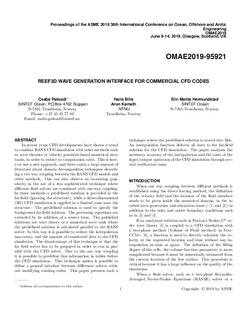| dc.contributor.author | Pakozdi, Csaba | |
| dc.contributor.author | Bihs, Hans | |
| dc.contributor.author | Kamath, Arun | |
| dc.contributor.author | Hermundstad, Elin Marita | |
| dc.date.accessioned | 2020-01-30T13:08:04Z | |
| dc.date.available | 2020-01-30T13:08:04Z | |
| dc.date.created | 2019-11-18T11:23:49Z | |
| dc.date.issued | 2019 | |
| dc.identifier.isbn | 978-0-7918-5877-6 | |
| dc.identifier.uri | http://hdl.handle.net/11250/2638903 | |
| dc.description.abstract | In recent years CFD developments have shown a trend to combine RANS CFD simulation with other methods such as wave theories or velocity potential based numerical wave tanks, in order to reduce to computation costs. This is however not a new approach, and there exists a large amount of literature about domain decomposition techniques describing a two way coupling between the RANS CFD models and other methods. One can also observe an increasing popularity in the use of a less sophisticated technique where different fluid solvers are combined with one-way coupling. In these methods a predefined solution is provided in the far-field (ignoring the structure), while a three-dimensional (3D) CFD simulation is applied in a limited zone near the structure. The predefined solution is used to specify the background far-field solution. The governing equations are extended by the addition of a source term. The published solutions use wave theory or a numerical wave tank where the predefined solution is calculated parallel to the RANS solver. In this way it is possible to reduce the interpolation inaccuracy and the amount of transferred data to the CFD simulation. The disadvantage of this technique is that the far field solver has to be prepared in order to run in parallel with the CFD solver. Due to the one way coupling it is possible to predefine this information in tables before the CFD simulation. This technique makes it possible to define a general interface between difference solvers without modifying existing codes. This paper presents such a technique where the predefined solution is stored into files. An interpolation function delivers all data to the far-field solution for the CFD simulation. The paper analyses the necessary accuracy of the interpolation and the costs of the input/output operation of the CFD simulation through several verification cases. | nb_NO |
| dc.language.iso | eng | nb_NO |
| dc.publisher | ASME | nb_NO |
| dc.relation.ispartof | ASME 2019 38th International Conference on Ocean, Offshore and Arctic Engineering (OMAE2019): Volume 2: CFD and FSI | |
| dc.title | REEF3D Wave Generation Interface for Commercial CFD Codes | nb_NO |
| dc.type | Chapter | nb_NO |
| dc.description.version | publishedVersion | nb_NO |
| dc.identifier.cristin | 1748663 | |
| dc.description.localcode | Copyright © 2019 ASME | nb_NO |
| cristin.unitcode | 194,64,91,0 | |
| cristin.unitname | Institutt for bygg- og miljøteknikk | |
| cristin.ispublished | true | |
| cristin.fulltext | postprint | |
| cristin.qualitycode | 1 | |
